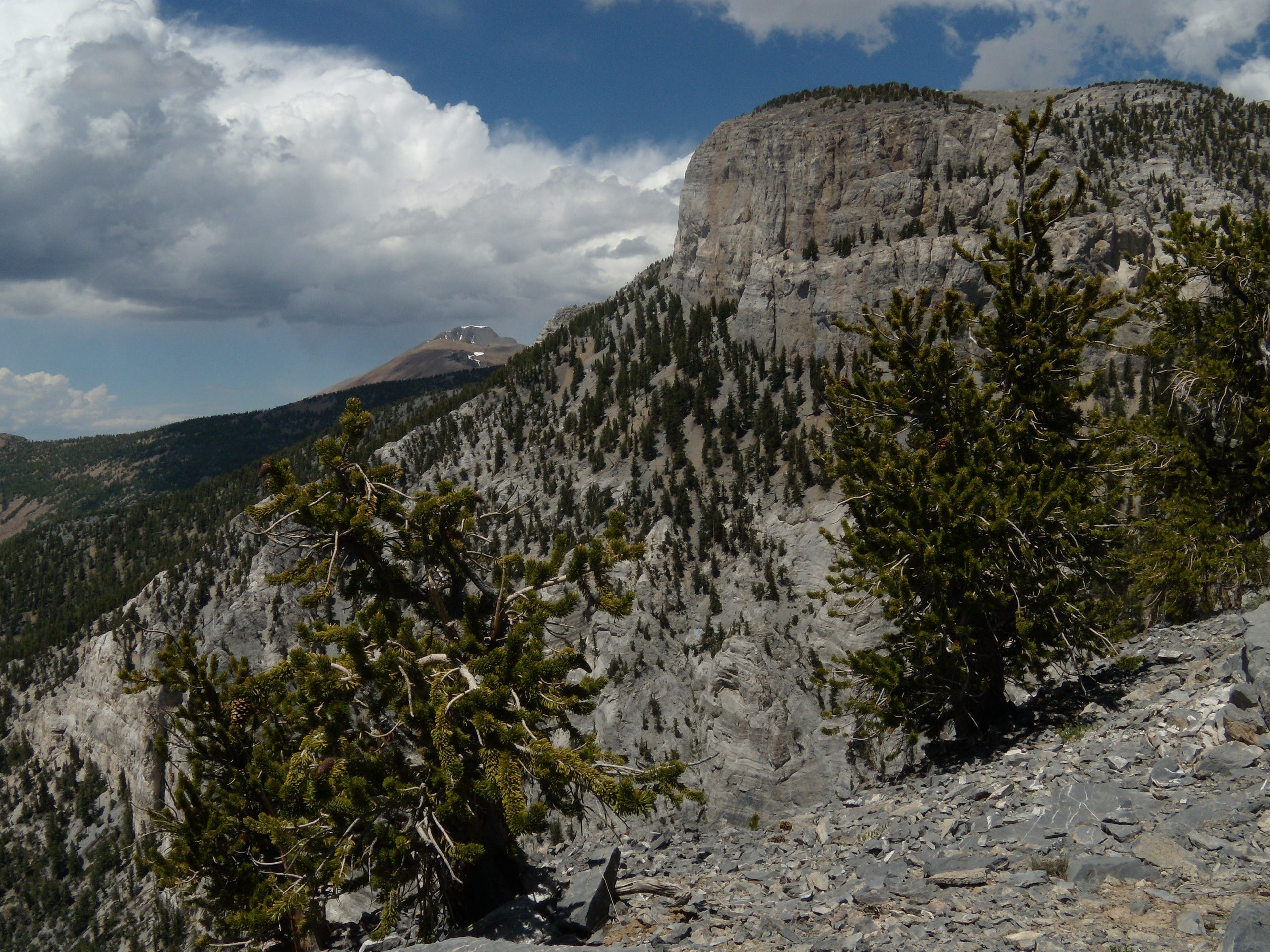
About 15 years ago, my work unexpectedly collided with mountain climate science research when the nonprofit organization I work for, The Long Now Foundation, acquired Mt. Washington in eastern Nevada (Fig. 1). Not the whole mountain, but important parts of it, and also parts of the adjacent Spring Valley. Long Now had been looking for a site to build its flagship artifact for the future, the 10,000 Year Clock, and originally acquired the properties with this in mind. For various reasons, this turned out not to be where we are currently constructing the 10,000 Year Clock, which is now in the installation phase in a mountain in west Texas. What we might create on Mt. Washington that is Clock-related is not yet planned. Still, the Mt. Washington and Spring Valley properties remain close to the heart of Long Now, and we conjure what could happen there. One possibility is a long-term science station. More on this below.
The Big Here and The Long Now
Long Now was first established in 01996 with the mission of fostering long-term thinking in society.¹ We modern humans live longer than our ancestors, yet increasingly our tendency is to think and operate in ever shorter time frames — the four-year election cycle, two-year science grant, annual federal budget, or the quarterly return. This is to the detriment of observing longer trends that might impact us, or in strategizing solutions to problems that might take multiple generations, or even centuries to implement. The idea of the “Long Now” (coined by Long Now board member, artist, and musician Brian Eno) is to shift one’s frame of reference, agency and responsibility from the local ‘here’ and short ‘now’ to the Big Here and Long Now — to thinking globally and long-term, and taking good care of one’s civilization.²
To define an operating framework, Long Now looks back 10,000 years to the dawn of human civilization and projects this into the next 10,000 years. In total, this 20,000-year span of history, present, and future is the “Long Now.” Rather than just taking this as an abstract concept, Long Now as an organization engages in projects that require us to take the Long Now seriously. One of these projects is the 10,000 Year Clock, designed to tick and keep time for 10,000 years. Another is The Rosetta Project, which is building an archive of all human languages and creating a backup that can last for thousands of years. Yet another is Long Bets, where you can lay down real money and make predictions of societal consequence, but the bet might not be decided for hundreds or thousands of years (the stakes go to the charity of the winner’s choice). Another project, Revive and Restore, recently spun off of Long Now, and is working on the de-extinction of species like the Passenger Pigeon and Woolly Mammoth. By taking the long-term seriously, we hope to inspire people and give them permission to think longer-term, even if that means ten years from now. We hope it also means 10,000 years from now.
A Clock and a Mountain
In many respects the 10,000 Year Clock is like an ordinary clock. It has a pendulum that ‘ticks’, it has chimes, it uses mechanical gears to track time. It is unusual in that it is built to reckon time for the next 10,000 years, is hundreds of feet tall, uses temperature differences between night and day as an energy source, and its siting requires a mountain (for more, see The Long Now Foundation 02018). When Long Now was looking for a mountain for the Clock, the late Roger Kennedy was on the Board of Directors. He had been head of the National Park Service shortly after Great Basin National Park was established. The park and surrounding area in the Snake Range, Nevada, are home to the impressively long-lived bristlecone pine (Pinus longaeva), one of which, the ill-fated Prometheus Tree (Fig. 2), was felled by the U.S. Forest Service in 01964 at the request of a geomorphology graduate student undertaking research to date glacial moraines. It was posthumously dated at 4,862 years old; at the time it was the oldest known non-clonal organism on Earth. Roger thought that the beauty and remoteness of the area, along with the millennially-ancient bristlecone pine groves would provide an epic and inspirational siting for the 10,000 Year Clock.
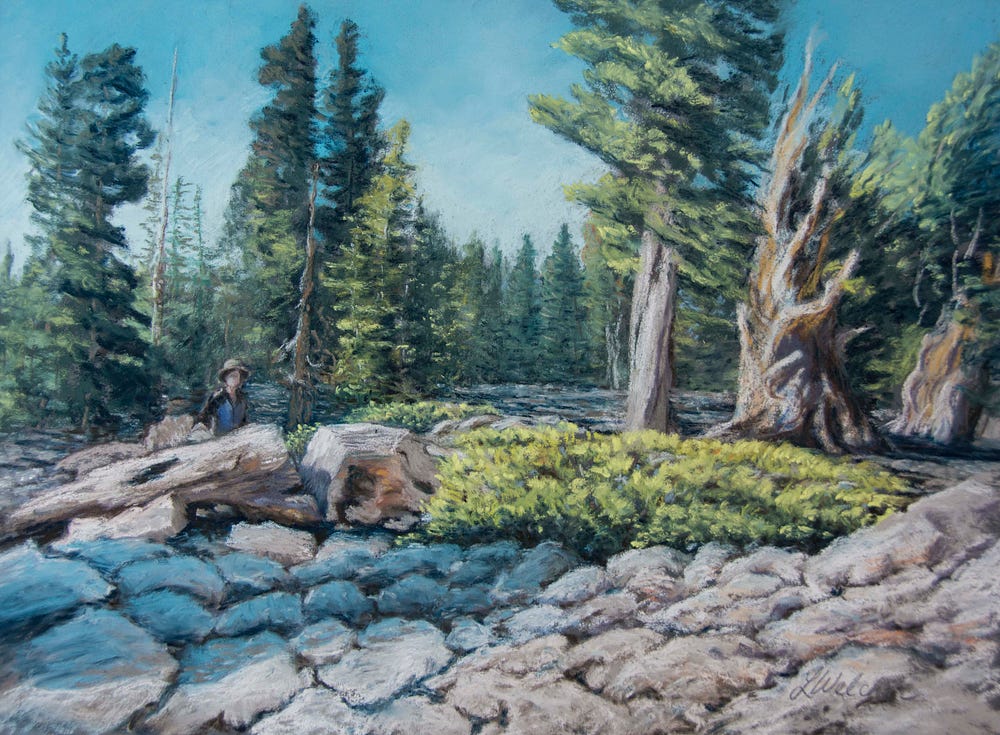
Just outside the park boundary, south of the tallest peak in the range Mt. Wheeler, lies Mt. Washington. On Mt. Washington’s western side is a gargantuan limestone cliff , reaching 11,657 feet in elevation at its summit. On its slopes, forests of pinyon pine (Pinus monophylla), juniper (Juniperus osteosperma) rise through limber pine (Pinus flexilis), Engelmann spruce (Picea engelmannii) and white fir (Abies concolor) culminating in open groves of stately bristlecone pine and alpine meadows, lush with flowers and pollinators on a midsummer’s day. In winter, it is blanketed by many feet of snow, and icy storms buffet its peak and flanks (Fig. 3).
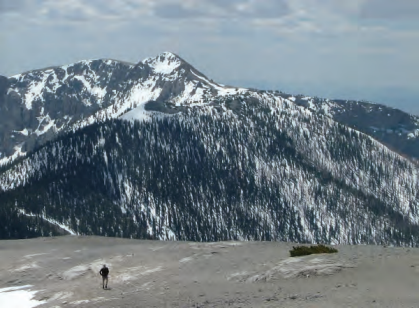
The property that Long Now purchased for the siting of the Clock is at the summit of Mt. Washington above the limestone escarpment. It was previously a sometimes-operating beryllium mine, and along with surface rights, Long Now acquired mineral rights to the property. Long Now has no interest in mining, but needed those rights in order to excavate inside the cliff, to create the chambers that would house the Clock and protect it from the elements. Long Now also acquired several patent mining claims heading south along the top of the cliff, and one non-patent claim known as the “Pole Adit” at about 7,800 feet on the western slope.
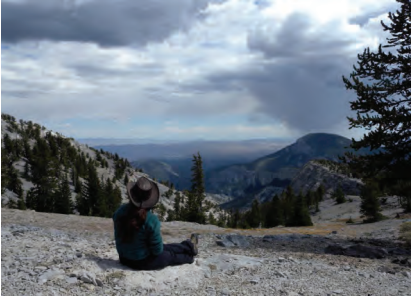
From atop the peak of Mt. Washington, looking westward the viewshed takes in Spring Valley (Fig. 4), a basin that at the time of Long Now’s purchase was mostly home to alfalfa farmers, sagebrush, sheep and scientifically-significant stands of Rocky Mountain junipers (Juniperus scopulorum, locally known as “Swamp Cedars”, Charlet 02006). Hidden from view, but supporting life in the valley, is an ancient aquifer evidenced here and there where it percolates to the surface in artesian wells. With the help of local realtor Dave Tilford, Long Now purchased its mountain properties, as well as a valley property along Highway 894 with resident Swamp Cedars. A few years later, Long Now also acquired a property sold by the local school board along Highway 50 near Majors Place. This property is slightly higher in elevation from the Swamp Cedar property, and has a glorious view of southern Spring Valley, Mt. Washington, and the western face of the Snake Range (Fig. 5).
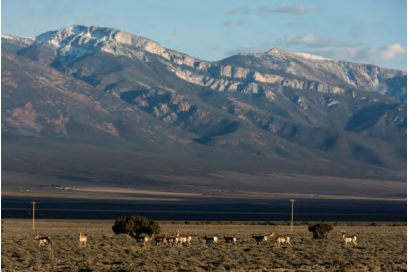
A Linguist and a Library
This is about where I enter the story. I came to The Long Now Foundation from an academic background in theoretical linguistics. My focus was on the documentation and description of certain indigenous languages of North America, which are today some of the most critically endangered languages on Earth (although many are also being revived as modern, spoken languages). I’d done my Ph.D. at UC Berkeley and was just wrapping up a year’s postdoc in Michigan, when I was hired by Long Now to work on The Rosetta Project.
The Rosetta Project, which at the time was just getting off the ground, is an effort to build an archive of all spoken languages on Earth (there are around 7,000 of them) and to create a backup of this archive that can last and be readable for thousands of years, The Rosetta Disk (The Rosetta Project 02018). The Rosetta Project was conceived as part of the Long Now Library — a companion collection to the 10,000 Year Clock intended to provide a “wisdom line” for humanity, the knowledge to rebuild civilization if necessary, and the context to re-think and re-tool when inspired to do so (Brand 01999). The Rosetta Project was the first entry in the Library, created as a key to whatever information we may leave to the future in the form of our human languages.
The Rosetta Project is a good place for a linguist and budding long-term thinker to hang her proverbial hat. Our 7,000 modern spoken languages, in roughly one hundred and fifty different language families, are the product of millennia of differentiation and change through isolation of speakers as well as contact between them and its associated multilingualism. To study human language in its modern diversity is to peer back through at least 6,000–8,000 years of human history, since that is what we can reconstruct for the better-studied language families like Indo-European. It is also a poignant time to take an archival snapshot of human language, since the total number of languages is bound to be drastically reduced within a century. A massive loss of species is often used as a metaphor for explaining the magnitude of this linguistic change we are witnessing in our lifetimes.
While I have had the charge of The Rosetta Project for several years at Long Now, I have had many other roles and responsibilities there as well (this is common in small nonprofit organizations). Over the years I have carried the titles of Rosetta Project Director, Development Director, and most recently Director of Operations and The Long Now Library. (I can even add a section to my CV for helping open and run the Long Now bar/café The Interval! If you had told me that as a graduate student, I never would have believed it.) Pretty early on in my tenure at Long Now I took on the role of helping manage the properties in Eastern Nevada and this is where I was first introduced to mountain climate science.
A Mountain and a Transect
In 02007, researchers at several institutions within the Nevada System of Higher Education contacted Long Now about a proposal they were developing to submit to the National Science Foundation’s EPSCoR (Established Program to Stimulate Competitive Research, National Science Foundation 2018a) grant competition. They wondered if Long Now might make its Spring Valley and Mt. Washington properties available for the siting of several semi-permanent environmental monitoring stations. The stations on Long Now properties would form a transect in various environments and elevations running roughly southwest to northeast across the Snake Range. Linked by radio, with relays to remote data centers, the whole system would define an area of data collection that could be used to study climate, ecology, and hydrology in this region of the Great Basin.
We listened with interest. Long Now had previously set up a small weather station of its own on Mt. Washington, but despite its remote and unadvertised location on the mountain, it was discovered and repeatedly vandalized (we did nevertheless manage to collect several years of data). This NSF project brought the possibility of a much more advanced set of instruments, with superior data collection through a linked data network that would be built and managed by climate scientists. Other than providing sites for the stations and access to them, Long Now would not be involved with their setup, operation or data collection.
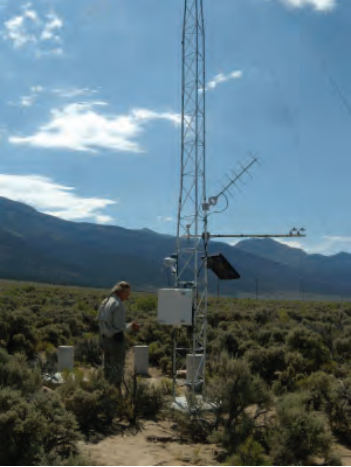
Long Now said yes to the use of its properties. The proposal was successful, and in 02008 the Nevada Climate-ecohydrology Assessment Network (NevCAN for short) was created by a five-year, fifteen million dollar grant (National Science Foundation 02018b). Three of the seven planned observatory stations for the Snake Range were built on Long Now properties, one in the valley off Highway 894 (Fig. 6) and two on the upper elevations of Mt. Washington. Another monitoring station was added to the network when Long Now acquired additional Spring Valley property off of Highway 50 in 02013.
Deep Time and Long Science
I first had the delight of meeting Scotty Strachan when he was a graduate student at the University of Nevada Reno and had taken charge of the building and communications of all the weather stations in the NevCAN network. These included not just the stations around Spring Valley and Mt. Washington in the Snake Range, but also four stations in southern Nevada in the Sheep Range. Scotty also linked all of the stations by radio and relayed their collected data via repeaters back to his data center at UNR (I should add, using some serious ham radio skills, of which I maintain a merely hobby interest and ability). The use of the network was a critical part of his doctoral research.
All of this, frankly, impressed the socks off of me. Studying linguistics at Berkeley when I did my Ph.D. meant establishing a close relationship with your data. You cut your teeth as a linguist theorizing about data that you, yourself, had collected. This practice instills a strong understanding of the contextual dependence of collected data as well as a responsibility to the longevity of that data and its potential reuse in the future — which also means communicating that contextual dependence to future data users. To this day, Berkeley linguists rarely stray far from field research, and typically base the research of their scholarly careers on it. Given that linguists today are also typically collecting data about languages that are critically endangered means we have a deep responsibility to those communities we work with, as well as to the world, for we are working to document world heritage. But creating a culture of data stewardship through its entire life cycle from collection to its preservation, access and reuse is a problem that has plagued the discipline of linguistics, and we are just beginning to sort it out. Here was my first encounter with climate scientists in the field, and despite all of the challenges inherent in digital data creation and management, they seemed light-years ahead.
Scotty and I kept in contact and over the years had many opportunities to meet up, including when he made annual maintenance trips to work on the stations in Spring Valley and the Snake Range. Often trips were combined with picking juniper berries which we used to flavor the gin for the Long Now bar/ café The Interval, or an ARRL ham radio field day atop Mt. Washington, and these all were a lot of fun. Many a night over a campfire we would talk about how fantastic it would be to build a science research station in Spring Valley. It could support resident scientists working on instrumentation and data collection using the NevCAN network. Building a cabin on Mt. Washington would enable researchers to stay at elevation while they did their work, and could provide shelter for winter field research as well.
What could set such a research station apart from other existing or proposed stations? To name a few, its focus on the Great Basin, and raising the profile of this important region for the study of climate science and human adaptation; its existing infrastructure with the NevCAN transect and the institutional relationship of the transect to the Nevada System of Higher Education; the scientifically important status of the Swamp Cedars and bristlecone pine populations to name just two species of interest. Doubtless there are many others.
Then, as an institutional partner of the research station, Long Now would bring an emphasis on “Long Science.” Stewart Brand devoted a chapter in his book The Clock of the Long Now to this idea (Brand 01999:138). He observed that:
[t]he benefits of very long-term scientific studies are so obvious it is hard to understand why they are so rare…. Enormous, inexorable power is in the long trends, but we cannot measure them or even notice them without doing extremely patient science.
He continues (Brand 01999:142):
If a Long Now Library gets established, one useful role for it might be to broker ambitious longitudinal studies with deep-pocketed — or steady-pocketed — funding sources. It might also guarantee long-term oversight and archival backup for the studies. When they are abandoned by their original researchers, it could try to find new keepers of the work, or at least preserve the accumulated material for later review or revival. Such a Library could foster cross-pollination among the long-term projects: correlating data and spreading the word on new tools, new uses for old data, and newly evolved best practices.
So over twenty years ago, Stewart Brand saw a role for Long Science within the Long Now.
Why is Long Science especially valuable in Spring Valley? Right now, given there is a proposed project to build a pipeline and pump groundwater out of the valley, the obvious problem in need of a good long-term solution is basin groundwater access and use (Southern Nevada Water Authority 02018). Sustainable adaptations to a changing climate require long-term observation, analysis, planning and implementation. A Long Science research station in Spring Valley could potentially serve as public oversight to the proposed water pipeline project — if the pipeline is built, there will most certainly be defined triggers where mitigation plans must be put into effect. We will need third-party, robust data collection and analysis for monitoring.
Besides this need, there are good avenues for connecting longterm research across several disciplines to build a detailed, multi-faceted scientific chronology of the region. The climate record in multi-millennial bristlecones pines is one, also packrat middens (Neotoma cinerea; N. lepida) and their 40,000 years’ record of fossilized plant material and pollen (Thompson 01990). Archaeology as well — as evidenced in the Baker, Nevada archaeological site, an agricultural community thrived in Snake Valley less than a millennium ago, in what today is an arid, dusty basin (Great Basin National Heritage Site 02018).
Long Now is a public-facing organization, and this is also important to its mission which is operating on the level of trying to change culture. We are always working to broaden our public engagement. So in addition to scientific residencies at the research station, we imagine resident artists and writers helping to open up the science to a broader audience. Stewart Brand observes that “science and art are always inspiring each other” (Brand 01999:142). Ideally, the resident scientists and artists would be in ongoing dialog with each other.
Then, our vision expands — with the more recently acquired property on Highway 50 we imagine a visitor center where people can come to learn about the work of the research station, and the importance of long-term thinking and science in the region. It would also be a great neighbor to the Great Basin National Park visitor centers on the east side of the Snake Range, and their growing emphasis on astronomy.³
Long Now and The Long Now
As I mentioned at the beginning, it isn’t clear whether Long Now will build a Clock on Mt. Washington. While we have the means to purchase property in Spring Valley and on Mt. Washington, we don’t have the funding to build the Clock itself. Mt. Washington also presents logistic challenges, not the least of which is a dirt access road that can’t handle regular travel or heavy equipment, and an elevation significant enough that it requires acclimatization, at least for anyone used to living near sea level. Also, the potential impact of construction on the alpine environment and the bristlecones pines is a serious consideration (Fig. 7).
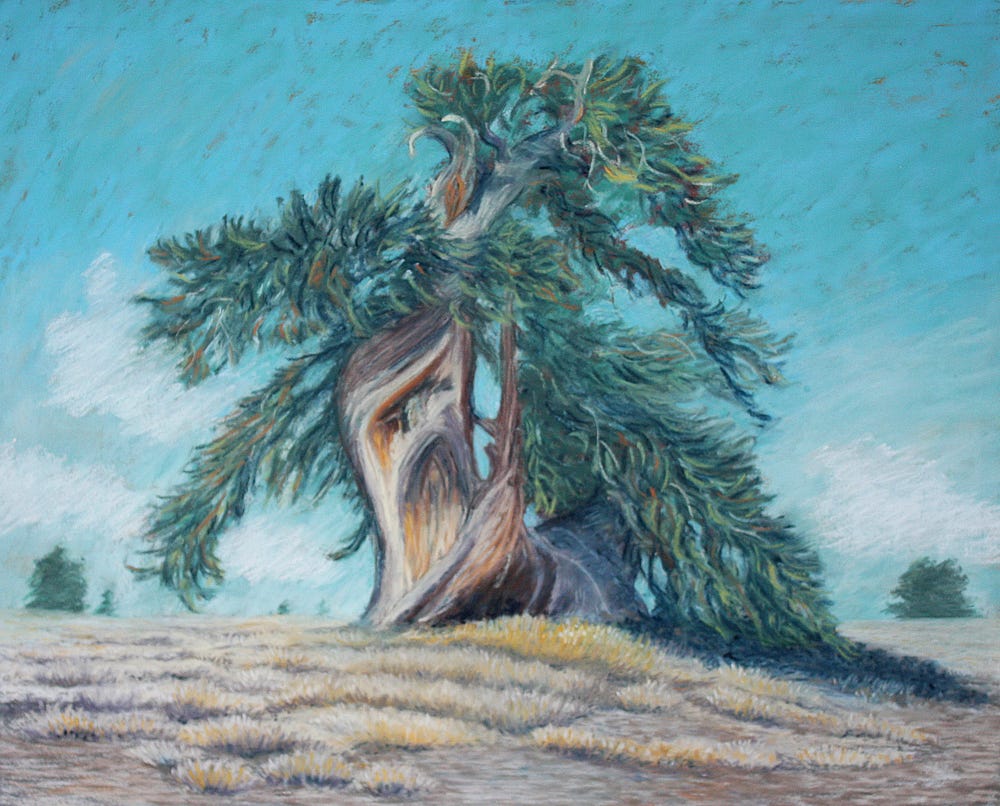
As board members have pointed out, we would be serving the Long Now mission by just holding the properties we have in Eastern Nevada, with their resident bristlecone pines and Swamp Cedars. But building something on Mt. Washington is certainly still on the table. Maybe it is some kind of a Clock. Maybe it is an observatory, as Danny Hillis, creator of the 10,000 Year Clock has mused. Maybe it is a library.
Maybe it is long-term science station.